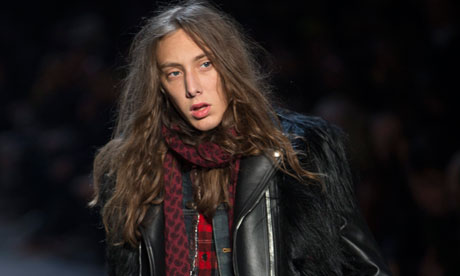
While Hedi Slimane's womenswear debut for Saint Laurent Paris had critics comparing the designer's 70s vision to Saint Laurent himself, his menswear range looked elsewhere for inspiration. In fact, the show recalled Slimane's own work at Dior Homme, right down to the incredibly thin models he favoured there. Slimane's work for Dior in the early 2000s pioneered a skinny rock'n'roll look, with angular boys in bands often replacing male models on the catwalk. But six years is a long time in fashion. Since Slimane last worked with a brand, different body shapes have emerged throughout menswear, with healthy, athletic look now battling for the top spot. And the shape of the models walking down the runway for each designer tells you a lot about the collections, and how menswear is evolving.
Saint Laurent Paris
With a cast of rock'n'roll models from obscure bands including Egyptian Hip Hop and Swim Deep, Slimane went with his trademark look: young boys who look like they could use a hot meal. This was common practice at Dior Homme – when members of the Cazals and These New Puritans took to the catwalk. In the new environment of menswear, though, it felt like a bit of a throwback to when Slimane left off – as if we're still humming Mika or rueing the breakup of Justin Timberlake and Cameron Diaz. Cheekbones were hollow, shoulders were slight and legs, encased in leather or artfully ripped jeans, were shocklingly twig-like. Style.com's respected reviewer Tim Blanks called the silhouette "a cliche in the lexicon of Slimanery". Like it or not, you'd have to agree.
Givenchy
Compare the third look shown by Givenchy with the Saint Laurent Paris show, and you will immediately notice the difference. If Slimane's boy is all hollow face and open-mouthed stare, Givenchy's is all man: a strong-jawed, wide-shouldered model with visible, ripped biceps. This healthy, jockish body type has become fashionable in recent years – at Givenchy but also at Calvin Klein and even JW Anderson – probably in reaction to the reedy boys of Slimane's Dior Homme days. It makes even more sense when you find out that Givenchy designer Ricardo Tisci was inspired by America for this collection.
Dolce & Gabbana
While the Italian duo were previously notorious for hunks in trunks, Dolce & Gabbana mixed it up last season – by going back to their roots. Almost all the models in their 85-look show were found in villages in Sicily – where Domenico Dolce hails from. All distinctly individual, they were boyish rather than the angular teenagers Slimane prefers. They were also the talk of the show – especially as they were such a dramatic change from the usual beefcake – so much so that the label brought them out this year too. In a show that referenced all sorts of Italian classics – from altar boy to aesthete – it worked second time around also.
Prada
Prada is a trailblazer in most areas, and model casting is no exception. Known for picking boys who go on to big things, the brand went offpiste, and into the headlines, last year when its included actors such as Willem Dafoe and Gary Oldman among the models in its autumn/winter 2012 show. This season had a similar slant – with models in their 30s and 40s mixing with fresh new faces, including one who had an interesting resemblance to Harry Styles. Miuccia Prada pontificated after the show that "normality could be provocative".
Versace
If Givenchy represents the new beefcake in fashion, it's fair to say Versace goes for a more classic version. Just look at the flesh on display in an average show: some part or other of a naked male model appeared in around a third of its autumn/winter show. Some of these didn't leave much to the imagination – with Spanx-type mesh shorts, complete with lace edges, involved in one look. Donatella Versace dedicated this show to masculinity: with male-model body types becoming more diverse as menswear gains more of a spotlight, these guys showed us that old-school machismo has a place in 21st-century fashion.

